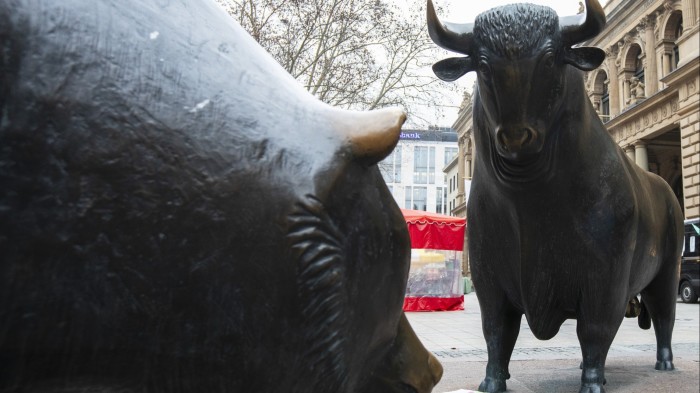Unlock the Editor’s Digest for free
Roula Khalaf, Editor of the FT, selects her favourite stories in this weekly newsletter.
The prospect of a ceasefire in Ukraine is adding a peace premium to an extraordinary start to the year in European markets.
Already, very much against the consensus, Europe has been the standout trade of 2025. Germany’s Dax has been breaking records, as has the pan-continental Euro Stoxx index. Whether you are measuring in sterling or euros, or converting to dollars, the percentage gains in many European markets are well in to double figures this year, trouncing the supposedly mighty US. Even the UK’s normally laggard FTSE 100 beats the US S&P 500. At the risk of making you feel old, this has been one of the strongest beginnings to any year in the region since 1987.
What has been missing here, though, is any sense of enthusiasm. The rally has been largely unloved, reflecting the absence of bad news — no across-the-board trade tariffs from Donald Trump (yet), and no serious blow-ups in the global government bond markets (also yet). It is a catch-up that also points to a mild case of nerves around highly concentrated, tech-heavy and politically charged US stock markets.
Through gritted teeth, Europe-haters (and American exceptionalism chest-thumpers) have been forced to accept they have overplayed their hand. So-called short covering, where investors with negative bets in effect give up, has played a large part in driving the gains in early 2025. Now, though, that phase is “done”, as Barclays put it in a note this week. “Positioning is no longer depressed,” Arihanth Bohra Jain and colleagues at the bank said, as short-term speculative accounts flipped from negative to positive.
“Not depressed” is hardly a ringing endorsement, but the narrative taking hold is that this not a blip. Bigger investors such as pension funds and insurers have, as usual, been slower than their flightier speculative peers — so far reversing less than 10 per cent of their recent sales of European stocks, the bank estimates. That suggests now is not the time to give up or lock in gains.
This is a key point. It is hard to overstate how deeply out of favour European markets have been over recent years. As Sharon Bell at Goldman Sachs wrote this week, European equities funds have suffered outflows almost every week since the full-scale invasion of Ukraine three years ago. For a lot of global investors, even just getting back to neutral on Europe, let alone to positive positions, leaves an enormous amount of money still to flood in.
With perfect timing, along comes the chance of some kind of peace deal in Ukraine, driven by the conversation this week between Trump and Russia’s Vladimir Putin. The arrangement they appear to be constructing is flawed and tawdry, blindsiding Europe and giving Ukraine itself little say over its own territory. But whether a deal between the Kremlin and the White House will produce results is still a big if.
Markets are simple creatures, however. When news of the talks landed on Thursday, it delivered a gain of more than 2 per cent in the Dax 40 — its best day in more than two years.
“For European equities, we see a number of potential benefits: lower risk premium, lower energy prices, better consumer confidence, stronger economic growth,” wrote Bell and colleagues at Goldman Sachs. “Our economists estimate a potential euro area GDP increase of 0.2 per cent in a limited ceasefire scenario and a 0.5 per cent boost in an upside scenario.”
Analysts and investors also see plenty of room for a peace process to play out in other pockets of the markets. Ukrainian government bonds jumped in price this week, pushing yields down to the lowest point in three years. The euro is also seen as a potential beneficiary, particularly if global investors keep snapping up European stocks. For the more adventurous or specialist investors out there, Bank of America lays out the case for small German stocks.
Outside of Moscow, no one here is popping champagne corks. The obstacles in the way of a durable peace deal are serious and it is hard to see how it could quickly fix Europe’s energy conundrum. “It is not obvious that a peace agreement would open up for renewed large-scale energy export from Russia to the EU or would allow European countries to reduce their rearmament ambitions,” wrote analysts at Danske Bank. “There would be a need for rebuilding Ukraine which could benefit some European companies, but also put further strains on public finances in EU countries.”
Aside from longer-term strategic concerns, another reason for caution is that European stocks are not as quite cheap as they seem. US stocks have streaked ahead of them in terms of valuations, of course, but as Bell points out, European price-to-earnings ratios are only a little lower now than they were on the eve of the February 2022 invasion, and they are still a little higher than the median over the past two decades. So they are cheap compared with the US, but not outlandishly cheap on their own terms.
Still, the positive shift in mood on Europe has already been striking, and the peace premium is clearly giving it extra momentum. The pessimists are very much on the back foot.
Read the full article here




